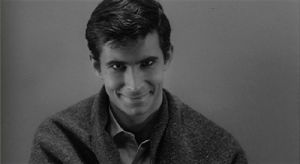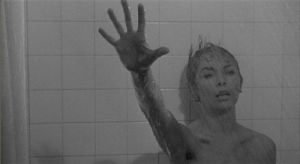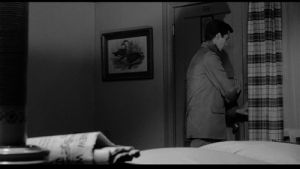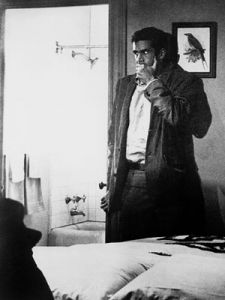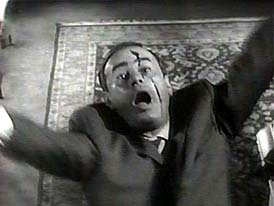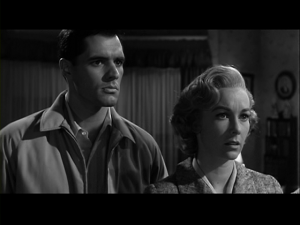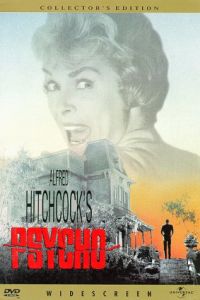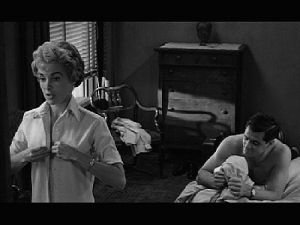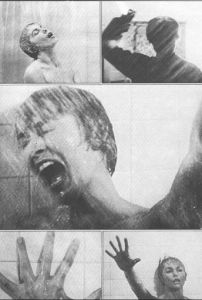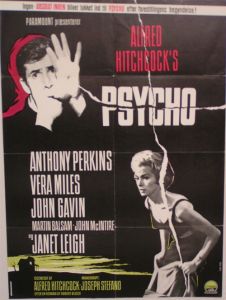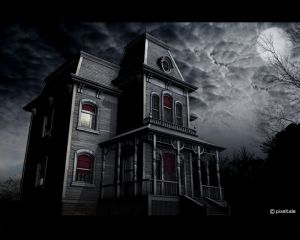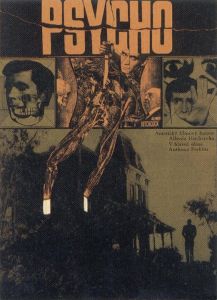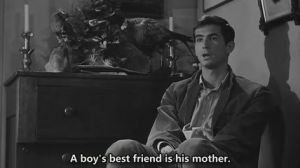Psycho
Psycho(惊魂记)is a 1960 American suspense film directed by Alfred Hitchcock. The film is based on the screenplay by Joseph Stefano, who adapted it from the 1959 novel of the same name by Robert Bloch. The novel was based on the crimes of Wisconsin serial killer Ed Gein.
Psycho initially received mixed reviews, but outstanding box office returns prompted a re-review which was overwhelmingly positive and led to four Academy Award nominations. Psycho is now considered one of Hitchcock's best films and is highly praised as a work of cinematic art by international critics.
Directed by: Alfred Hitchcock
Produced by: Alfred Hitchcock
Written by: Joseph Stefano
Music by: Bernard Herrmann
Cinematography: John L. Russell
Editing by: George Tomasini
Studio: Shamley Productions
Distributed by:
Paramount Pictures(1960–1968)
Universal Pictures(1968-present)
Release date: June 16, 1960
Running time: 108 minutes
Country: United States
Language: English
Genre: suspense thriller
Anthony Perkins as Norman Bates, the mentally ill young man who operates the Bates Motel.
Janet Leigh as Marion Crane, the woman who steals $40,000 in cash and is later murdered at the Bates Motel while taking a shower.
John Gavin as Sam Loomis, the boyfriend of Marion Crane. He later joins her sister Lila to find out about Marion's disappearance.
Vera Miles as Lila Crane Marion's sister who joins Sam Loomis to find out about her sister's murder.
Martin Balsam as Detective Milton Arbogast, the private investigator hired to solve the disappearance of Marion Crane. He is later murdered in the Bates Mansion.
Frank Albertson as Tom Cassidy, the wealthy rancher who hands over the $40,000.
Patricia Hitchcock as Caroline, Marion Crane's coworker.
John Anderson as California Charlie, the car dealer who helps Marion trade in her old car for a new one.
Mort Mills as the highway patrolman who questions Marion when he finds her pulled over to the side of the road.
Simon Oakland as Dr. Fred Richmond, the psychiatrist in the county where Bates Motel is located.
John McIntire as Sheriff Al Chambers, the local sheriff who lives not far from the Bates Motel.
Lurene Tuttle as Mrs. Chambers, the sheriff's wife.
Ted Knight as a police officer in the ending sequence.
A Friday afternoon, Marion Crane (Leigh) and her boyfriend Sam Loomis (Gavin) meet in a cheap hotel room in Phoenix. Marion is clearly unhappy, torn between her desire to be with Sam and her shame at these discreet meetings. But, Sam explains that between his father's unpaid debts and alimony payments to his ex-wife he is forced to live in the back room of a store. Until his finances improve, they cannot marry.
Marion returns to find that her boss who has just sold a house to the rich Tom Cassidy (Frank Albertson), for $40,000. Marion's boss is uncomfortable with that amount of cash in the office and asks Marion to deposit it at the bank for the weekend, explaining that he'll get Tom to write a check the next week. Instead of depositing the money she packs, steals $40,000 from her employer to marry her boyfriend Sam Loomis (John Gavin), and she flees to Sam's house with the money.
Along the way, she trades in her car to evade authorities. Driving at night in the pouring rain, Marion realizes that she can go no further and turns off at the sign for the Bates Motel. The place seems deserted, but she notices the figure of a woman in the window of the house around back. Hearing her call, Norman Bates (Perkins), runs down from the house and helps her into the office.
The motel, he explains, receives few visitors. Only those who are lost or take the wrong turn ever come here, but Norman keeps it open to give him some relief from taking care of his ailing mother. Norman cheerfully offers to share his dinner with her rather than force her back out into the storm. While settling into her room Marion overhears a fight between Norman and his mother through the open window. The mother refuses to allow Marion to come up to the house, accusing Norman of him lacking the "guts" to send Marion away. Norman sheepishly brings some food down to the motel, inviting Marion to dine in the office's parlor, which is gaudily decorated with examples of Norman's hobby of taxidermy—birds. As she eats, Marion discovers that Norman's mother is not only ill, but also overly controlling of her son. As they talk Marion comes to realize that she must return to Phoenix and make amends.
It turns out that Bates' mother is not ill physically, but mentally. Afterward, Marion returns to her room, where she decides to avoid a similar trap and resolves to return the money. Norman, who has become intrigued with her, watches her undress through a hole in the wall, obscured by a painting. After Marion counts the money, she takes a shower. During the shower, an anonymous female assailant enters the bathroom and stabs her to death. Bates is horrified when he finds the corpse, but cleans up as if he has done this several times before. Her car, belongings, and the money are sunk in a swamp behind the Bates' property.
Marion's sister Lila (Miles) drives to meet Sam, unable to believe that her sister took the money. As they talk another individual arrives, a private detective Milton Arbogast (Balsam), sent by Tom Cassidy to recover his money. Arbogast explains that he was following Lila in hopes that she would lead him to Marion. It soon becomes clear, however, that Sam is unaware of either Marion's whereabouts or the theft. Arbogast then is able to trace her to the Bates Motel, calling Lila and Sam to let them know. But Arbogast's curiosity proves fatal when, upon returning to the motel, he climbs up to the old house to talk with mother and at the top of the stairs is attacked by a person who slashes his face with a knife, pushes him down the stairs, and then stabs him to death..
When the detective fails to report back, Sam and Lila become convinced that he must have discovered something important, possibly from Norman's mother, and decide that it is time to involve the law. But the local sheriff is skeptical of their story. For Norman, he explains, lives alone at the Motel, his mother having died 10 years earlier in a particularly gruesome murder.
Lila and Sam realize that they must go to the motel themselves to see what Arbogast had discovered. While Sam distracts Norman down at the office, Lila goes up to the house to talk with mother. Sam tries to pressure Norman into admitting that he stole Marion's money, but the argument escalates into violence and Norman is able to knock Sam unconscious, and flee up to the house. Hearing Norman enter the house, Lila slips down to the basement only to find the corpse of Bates' mother. At that moment the killer is revealed to be Norman Bates himself. He dresses in his mother's clothing and carries a knife to attack Lila. But Sam appears at this moment and is able to wrestle the butchers knife out of Norman's clawed hand.
After Norman's arrest , a forensic psychiatrist (Oakland) explains to Lila, Sam and the police that Bates' mother, though dead, lives in Norman's psyche. Norman was so dominated by his mother, and so guilt-ridden over having murdered her 10 years earlier when it appeared she was about to remarry, that he had tried to erase the crime from his mind by bringing his mother back. Physically, which was done by exhuming her corpse and preserving it with his taxidermy skills, but mentally which was accomplished by allocating half of his personality to his mother. He acted as she would, talked as her, and even dressed as her in an attempt to erase her absence. And because Norman was so very jealous of his mother, he assumed she was also jealous of any woman he was attracted to. The Norman personality had convinced itself that his mother was not dead. Finally, Norman sits in a cell, thinking in his mother's voice.
James Cavanaugh wrote the original screenplay. Hitchcock rejected it, saying that the story dragged and read like a television short horror story. His assistant recalls that the treatment was very dull. Hitchcock reluctantly agreed to meet with Stefano, who had worked on only one film before. Despite his newness to the industry, the meeting went well, and Stefano was hired.
The screenplay is relatively faithful to the novel, with a few notable adaptations by Hitchcock and Stefano. The book features Mary Crane, as its heroine. Since, at the time, a real Mary Crane existed in Phoenix, Hitchcock renamed the character Marion Crane. When developing the characters for film, Hitchcock asked Stefano why he did not like the Norman Bates character, to which Stefano replied that Norman was unsympathetic, unattractive, and a drinker. Some changes Stefano made for the screenplay from the novel mainly include the location of Arbogast's death from the foyer to the stairwell. He also changed the novel's budding romance between Sam and Lila to just a friendly relationship, and instead of using the two to explain Norman's mental condition he replaced them with a professional psychiatrist.
Paramount, whose contract guaranteed another film by Hitchcock, did not want Hitchcock to make Psycho(惊魂记) and denied him his usual budget. So, Hitchcock financed the film's creation through his own Shamley Productions, shooting at Universal Studios under the Revue television unit. Hitchcock's original Bates Motel and Psycho House movie set buildings, which were constructed on the same stage as Lon Chaney Sr.'s The Phantom of the Opera, are still standing at Universal Studios in Universal City near Hollywood and are a regular attraction on the studio's tour. As a further result of cost cutting, Hitchcock chose to film Psycho in black and white, keeping the budget under $1,000,000. Other reasons for shooting in black and white were to prevent the shower scene from being too gory and that he was a fan of Les Diaboliques's use of black and white.
To keep costs down, Hitchcock took most of his crew from his television series Alfred Hitchcock Presents, including the cinematographer, set designer, script supervisor, and first assistant director. He hired regular collaborators Bernard Herrmann as music composer, George Tomasini as editor, and Saul Bass for the title design and storyboarding of the shower scene. In all, his crew cost $62,000.
Through the strength of his reputation, Hitchcock cast Leigh for a quarter of her usual fee, paying only $25,000. His first choice, Leigh agreed after having only read the novel and making no inquiry into her salary. Her co-star, Anthony Perkins, agreed to $40,000. Both stars were experienced and proven box-office draws.
The film, independently produced by Hitchcock, was shot at Revue Studios, the same location as his television show. Psycho was shot on November 11, 1959 and ending on February 1, 1960. Filming started in the morning and finished by six or earlier on Thursdays. Nearly the whole film was shot with 50 mm lenses on 35 mm cameras. This trick closely mimicked normal human vision, which helped to further involve the audience.
Before shooting began in November, Hitchcock dispatched assistant director Hilton Green to Phoenix to scout locations and shoot the opening scene. The shot was supposed to be an aerial shot of Phoenix that slowly zoomed into the hotel window of a passionate Marion and Sam. Another crew filmed day and night footage on Highway 99 between Fresno and Bakersfield, California for projection when Marion drives from Phoenix. They also provided the location shots for the scene where she is pulled over by the highway patrolman. In one street scene shot in downtown Phoenix, Christmas decorations were discovered to be visible, rather than re-shoot the footage, Hitchcock chose to add a graphic to the opening scene marking the date as "Friday, December the Eleventh".
Both the leads, Perkins and Leigh, were given freedom to interpret their roles and improvise as long as it did not involve moving the camera. An example of Perkins' improvisation is Norman's habit of munching on candy corn.
Throughout filming, Hitchcock created and hid various versions of the “Mother corpse” prop in Leigh's dressing room closet. There were no hard feelings, as Leigh took the joke well, and she wondered whether it was done to keep her on edge and thus more in character or to judge which corpse would be scarier for the audience.
During shooting, Hitchcock was forced to uncharacteristically do retakes for some scenes. The final shot in the shower scene, which starts with an extreme close-up on Marion's eye and pulls up and out, proved very difficult for Leigh, since the water splashing in her face made her want to blink, and the cameraman had trouble as well since he had to manually focus while moving the camera. Retakes were also required for the opening scene, since Hitchcock felt that Leigh and Gavin were not passionate enough. Leigh had trouble saying "Not inordinately" for the real estate office scene, requiring additional retakes. Lastly, the scene in which the mother is discovered required complicated coordination of the chair turning around, Miles hitting the light bulb, and a lens flare, which proved to be the sticking point. Hitchcock forced retakes until all three elements were to his satisfaction.
A series of shots with Arbogast going up the stairs in the Bates house before he is stabbed were directed by Hilton Green was later re-shot by Hitchcock, though a little of the cut footage made its way into the film. Filming the murder of Arbogast proved problematic due to the overhead camera angle necessary to hide the film's twist. A camera track constructed on pulleys alongside the stairway together with a chair-like device had to be constructed and thoroughly tested over a period of weeks.
The film was so successful that it was reissued to theaters in 1965. A year later, CBS purchased the television rights for $450,000. CBS planned to televise the film on September 23, 1966, but three days prior Valerie Percy, daughter of Illinois senate candidate Charles H. Percy, was murdered. As her parents slept mere feet away, she was stabbed a dozen times with a double-edged knife. In light of the murder, CBS agreed to postpone the screening, but as a result of the Apollo pad fire of January 27, 1967, the network washed its hands of Psycho. Following another successful theatrical reissue in 1969, the film finally made its way to television in one of Universal's syndicated programming packages for local stations in 1970. Psycho was aired for twenty years in this format, then leased to cable for two years before returning to syndication as part of the "List of a Lifetime" package.
Psycho(惊魂记)broke all film conventions by displaying its leading female protagonist having a lunchtime affair in her sexy white undergarments in the first scene and also by photographing a toilet bowl and flush in a bathroom, which is a first in an American film.
One of the most famous scenes in cinema history, is the murder of Janet Leigh's character in the shower. It was shot from December 17 to December 23, 1959, and features 77 different camera angles. Most of the shots are extreme close-ups, except for medium shots in the shower directly before and directly after the murder. The combination of the close shots with the short duration between cuts makes the sequence feel longer, more subjective, more uncontrolled, and more violent than would the images if they presented alone or in a wider angle.
In order to capture the straight-on shot of the shower head, the camera had to be equipped with a long lens. The inner holes on the spout were blocked and the camera placed farther back, so that the water appears to be hitting the lens but actually went around and past it.
It is often claimed that, despite its graphic nature, the "shower scene" never once shows a knife puncturing flesh. However, a frame by frame analysis of the sequence clearly shows one shot in which the knife penetrates Leigh's abdomen; actually a prosthetic prop used for this shot. Leigh herself was so affected by this scene when she saw it, that she no longer took showers unless she absolutely had to; she would lock all the doors and windows and would leave the bathroom and shower door open. She never realized until she first watched the film "how vulnerable and defenseless one is".
Psycho(惊魂记)has become one of the most recognizable films in cinema history. The iconic shower scene is frequently spoofed, given homage to and referenced in popular culture, complete with the violin screeching sound effects. It is referenced in films: the 1978 horror film Halloween, the 1977 High Anxiety, the 1980 Fade to Black, the 1980 Dressed to Kill, Invader Zim, Dexter's Laboratory, Kirby: Right Back at Ya!, and the 2003 live-action/animated Looney Tunes: Back in Action.
In the novel of same name, an uncommon plot structure is used: he repeatedly introduced sympathetic protagonists, then killed them off. This played on his reader's expectations of traditional plots, leaving them uncertain and anxious. Hitchcock recognized the effect this approach could have on audiences, and utilized it in his adaptation, killing off Leigh's character at the end of the first act. This daring plot device, coupled with the fact that the character was played by the biggest box-office name in the film, was a shocking turn of events in 1960.
The most original and influential moment in the film is the "shower scene", which became iconic in pop culture because it is often regarded as one of the most terrifying scenes ever filmed. Part of its effectiveness was due to the use of startling editing techniques borrowed from the Soviet montage filmmakers, and to the iconic screeching violins in Bernard Herrmann's musical score.
Hitchcock insisted that Bernard Herrmann write the score for Psycho, in spite of the composer's refusal to accept a reduced fee for the film's lower budget. The resulting score, according to Christopher Palmer in The Composer in Hollywood (1990) is "perhaps Herrmann's most spectacular Hitchcock achievement." Hitchcock was pleased with the tension and drama the score added to the film, later remarking "33% of the effect of Psycho was due to the music."
Herrmann used the lowered music budget to his advantage by writing for a string orchestra rather than a full symphonic ensemble. He thought of the single tone color of the all-string soundtrack as a way of reflecting the black and white cinematography of the film. Hollywood composer Fred Steiner, in an analysis of the score to Psycho, points out that string instruments gave Herrmann access to a wider range in tone, dynamics and instrumental special effects than any other single instrumental group would have.
The main title music, a tense, contrapuntal piece, sets the tone of impending violence, and returns three times on the soundtrack. Though nothing shocking occurs during the first 15-20 minutes of the film, the title music remains in the audience's mind, lending tension to these early scenes. Herrmann also maintains tension through the slower moments in the film through the use of ostinato.
There were rumors that Herrmann had used electronic means, including amplified bird screeches to achieve the shocking effect of the music in the Shower Scene. The effect was achieved, however, only with violins in a "screeching, stabbing sound-motion of extraordinary viciousness." The only electronic amplification employed was in the placing of the microphones close to the instruments, to get a harsher sound. Besides the emotional impact, the Shower Scene cue ties the soundtrack to birds. The association of the Shower Scene music with birds also telegraphs to the audience that it is Norman, the stuffed-bird collector, who is the murderer rather than his mother. The blood in the scene is in fact chocolate syrup, which shows up better on black-and-white film, and has more realistic density than stage blood. The sound of the knife entering flesh was created by plunging a knife into a melon.
Hitchock was originally opposed to having music in this Shower Scene. When Herrmann played the Shower Scene cue for Hitchcock, the director approved its use in the film.
Initial reviews of the film were thoroughly mixed.
negative reviews stated, "a blot on an honorable career", "plainly a gimmick movie", and "merely one of those television shows padded out to two hours."
Positive reviews stated, "Anthony Perkins' performance is the best of his career... Janet Leigh has never been better", "played out beautifully".
The public loved the film, one of whose reviews stated, "This isn’t a gory film, and what few instances of violence take place with relatively little actual on-screen violence. In fact, it contains just three big shocks, with the rest of the 110-minute running time devoted to setting scenes, building suspense and playing with our minds. But those three shocks comfortably better practically anything from the modern day canon of horror fair – Hitchcock sees to that nicely."
Awards
Edgar Allan Poe Awards: Best Motion Picture
Golden Globe Awards: Best Supporting Actress
Nominations
Academy Awards (33rd):
Director: Alfred Hitchcock
Best Supporting Actress: Janet Leigh
Best Cinematography, Black-and White: John L. Russell
Best Art Direction-Set Decoration, Black-and-White: Joseph Hurley, Robert Clatworthy, George Milo
Directors Guild of America:
Outstanding Directorial Achievement in Motion Pictures: Alfred Hitchcock
Rankings
No.18, AFI's 100 Years... 100 Movies
No.1, AFI's 100 Years... 100 Thrills
No.2, Norman Bates (Villain), AFI's 100 Years... 100 Heroes and Villains
No.56 "A boy's best friend is his mother.", AFI's 100 Years... 100 Movie Quotes
No.4, AFI's 100 Years of Film Scores
No.14, AFI's 100 Years... 100 Movies
Psycho: a slang word for a person who is either psychopathic or psychotic
Ostinato: a continuously repeated musical phrase
CBS: Columbia Broadcasting System
附件列表
词条内容仅供参考,如果您需要解决具体问题
(尤其在法律、医学等领域),建议您咨询相关领域专业人士。
如果您认为本词条还有待完善,请 编辑
上一篇 TEM-8改错部分应试技巧 下一篇 郭磊——英语学习需要投入大量精力和毅力

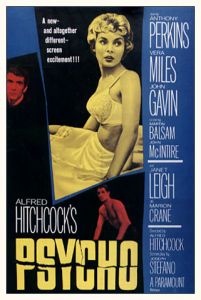
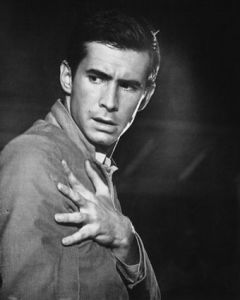
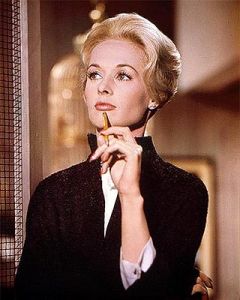
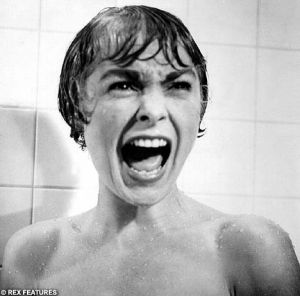
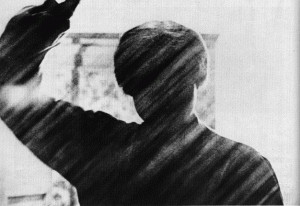
![] ]](http://www.dioenglish.com/wiki/uploads/201002/1265167633KzdqAoup_s.jpg)
